

How to Build A Raised Planting Bed. The bed’s 4 sides each need 3 courses of timbers to rise more than a foot above ground, for a total of 12 timbers.

Because it’s best to have full pieces on each side, buy stock lengths at least as long as the dimensions of your bed. Make sure each timber is straight and clear of knots on at least one side. to make a railing to cap the bed’s walls to secure the first course of timbers to the ground. These are usually sold in 18- to 24-inch lengths. How to Plant Apple Seeds: 7 Steps. Edit Article Edited by Molly, Fianchetto, Maluniu, Tiagoroth and 10 others When you enjoy an apple, you probably don't think about the fact the tiny seeds in the core can actually produce an apple tree.

Though it would take many years for a young tree to produce fruit that might not be of very good quality, it is possible to germinate an apple seed so that you can watch your seedling turn into an actual apple tree. Whether you are learning how to plant apple seeds for a school project, a gardening challenge or to satisfy your curiosity about the potential of the seeds, it takes specific care to ensure that the delicate process results in an apple tree seedling. Ad Steps Apple Seeds Step 1.360p.mp4 00:00 00:07 00:07 spaceplay / pauseescstopffullscreenshift + ←→slower / faster (latest Chrome and Safari)←→seek . seek to previous 12…6 seek to 10%, 20%, …60% 1Extract apple seeds from a fresh apple. Tips. HOW TO GROW AN ORANGE TREE FROM SEED.
Growing orange trees from seed is surprisingly straight forward, and something that anyone can do if they have a warm, sunny windowsill.
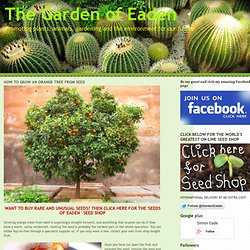
Getting the seed is probably the hardest part of the whole operation. You can either buy on-line through a specialist supplier or, if you only want a few, collect your own from shop bought fruit. Once you have cut open the fruit and exposed the seed, remove the seed and wash off any fruit residue. You should always clean seed collected from within fruiting bodies as they will normally contain chemicals which actively prevent seed germination. Planting Vegetables from Seed and Seedling. By The National Gardening Association, Bob Beckstrom, Karan Davis Cutler, Kathleen Fisher, Phillip Giroux, Judy Glattstein, Mike MacCaskey, Bill Marken, Charlie Nardozzi, Sally Roth, Marcia Tatroe, Lance Walheim, and Ann Whitmanfrom Gardening All-in-One For Dummies You can plant vegetable seeds indoors or outdoors.
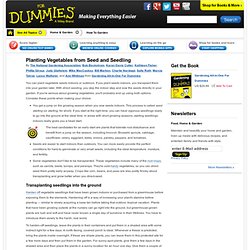
If you plant seeds indoors, you transplant them into your garden later. With direct seeding, you skip the indoor step and sow the seeds directly in your garden. Grow Vegetables in the Shade - Ten Vegetables You Can Grow Without Full Sun. By Colleen Vanderlinden When most people picture a vegetable garden, they imagine a spot that bakes in the sun all day.
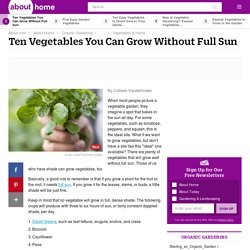
For some vegetables, such as tomatoes, peppers, and squash, this is the ideal site. What if we want to grow vegetables, but don't have a site like this "ideal" one available? There are plenty of vegetables that will grow well without full sun. Those of us who have shade can grow vegetables, too. Basically, a good rule to remember is that if you grow a plant for the fruit or the root, it needs full sun. Keep in mind that no vegetable will grow in full, dense shade. Gardening with Epsom Salt. Epsom salt is a popular and well-reputed supplement in organic gardening.
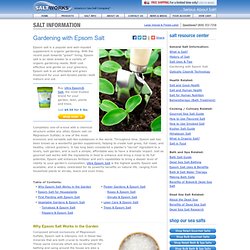
With the recent push towards “green” living, Epsom salt is an ideal answer to a variety of organic gardening needs. Three Sisters Garden: Corn, Beans, Squash - A Native American tradition. Early European settlers would certainly never have survived without the gift of the Three Sisters from the Native Americans, the story behind our Thanksgiving celebration.
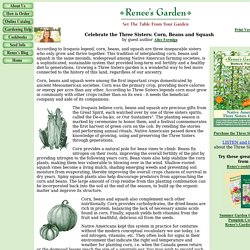
Celebrating the importance of these gifts, not only to the Pilgrims but also to civilizations around the globe that readily adopted these New World crops, adds meaning to modern garden practices. Ideas for Polycultures / Companion planting. Often we see these tables "companion planting" in the internet.
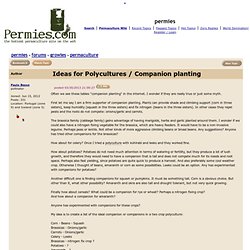
I wonder if they are really true or just some myth. First let me say I am a firm supporter of companion planting. Plants can provide shade and climbing support (corn in three sisters), keep humidity (squash in the three sisters) and fix nitrogen (beans in the three sisters). In other cases they repel pests and the roots do not compete: onions/garlic and carrots. The brassica family (cabbage family) gains advantage of having marigolds, herbs and garlic planted around them. How about for celery? How about potatoes? Organic sources for phosphorus - Organic Gardening Forum. Organic Sources of Potassium for Your Lawn or Garden. Hardwood ashes are a popular “home-made” source of potassium.
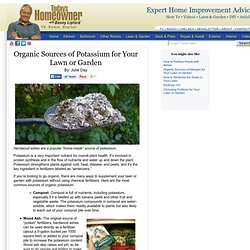
Potassium is a very important nutrient for overall plant health. It’s involved in protein synthesis and in the flow of nutrients and water up and down the plant. Watering and Fertilizing Summer Squash. By watering and fertilizing summer squash plants, you can help them reach their full potential and maximize fruit production.

After all, you've spent the time and money planting the seeds. Now is the time to make sure your hard work pays off in a big way. Fertilizing Summer Squash Plants.